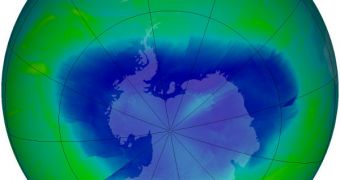Over the past few years, scientists have been saying that the ozone layer above Antarctica is getting smaller. That may be so, but the feature still appears, grows, and then disappears yearly.
Now, experts at NASA analyze the beginnings of this year's hole, which is the popular name given to the annual depletion of stratospheric oxygen above the Southern Continent.
The general trend is indeed one of recovery, in the sense that, over the past few years, the maximum size the hole catches on after it starts growing diminishes constantly.
But climate scientists are still keeping an eye on how the atmospheric structure evolves, so as to prevent any unpleasant “surprises.”
The hole started developing decades ago, as the world was releasing large amounts of chemical compounds known as chlorofluorocarbons (CFC) into the atmosphere.
These substances are found in refrigerators and in body sprays, and their release has the potential to destroy the existing ozone layer surrounding Earth.
This layer is extremely important, as it is the only thing standing between the surface of the planet and dangerous solar radiation, in the ultraviolet portion of the electromagnetic spectrum.
Producing and eliminating CFC has been forbidden under the 1986 Montreal Protocol on Substances That Deplete the Ozone Layer. The document has been ratified by 196 states, and is widely considered to be the best example available of international cooperation.
It is currently expected that, if all countries abide by the treaty's specifications, the ozone layer would recover completely within four decades.
The current depletion “started in early August 2010 and is now expanding toward its annual maximum,” say experts with NASA's Earth Observatory.
“The hole in the ozone layer typically reaches its maximum area in late September or early October, though atmospheric scientists must wait a few weeks after the maximum to pinpoint when the trend of ozone depletion has slowed down and reversed,” they add.
NASA is regularly training its satellites on an area above Antarctica, where ozone concentrations exist well the historical levels of 22 Dobson units.
The term “hole” is a metaphor, in the sense that no portion of the atmosphere is completely devoid of the chemical. But some areas exhibit very low concentrations of the stuff.

 14 DAY TRIAL //
14 DAY TRIAL //